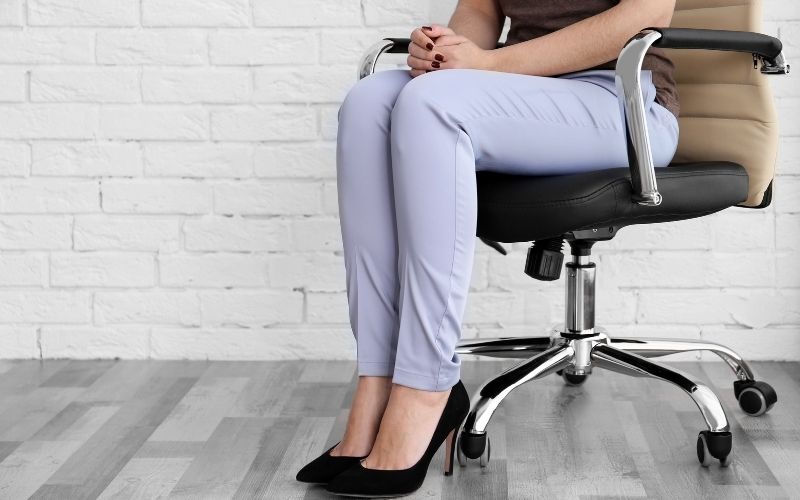If you spend hours on an office chair, then you’ve probably noticed your neck hurts once in a while. For some, this neck pain has been their constant companion.
Neck pain can be caused by a lot of things—from working too long in a sitting position, having the wrong chair height, having bad posture, etc. Even stress can be a culprit!
But there are things that we can do to solve some of these neck aches, such as standing every so often, aligning your monitor to your eye level, and adjusting your chair so that it’s at the proper height with the desk.
And yes, that starts with knowing what part of your desk and chair setup isn’t ergonomic.
By the end of this post, you’ll be able to identify areas where you can improve your work setup and ultimately support your neck while you’re working.
Table of Contents
Can a Bad Office Chair Cause Neck Pain?

Yes, a bad office chair is linked to neck pain. When we say ‘bad,’ this means that your office chair isn’t ergonomic or it isn’t adjusted to fit your height and your office desk.
This is why there has been a big demand for ergonomic chairs. If you’ve been working from home, there’s a high chance that you’ve started looking for one to use too.
Ergonomic chairs are said to help reduce neck pain. Non-ergonomic chairs, however, don’t exactly help your cause here.
Instead, non-ergonomic chairs reinforce slouching, hunching over the desk, or bending your neck forward.
All these things contribute to neck pain, and it’s just the office chair we’re talking about here.
Why does my neck hurt in my office chair?
There are several reasons why your neck hurts when you’re in your office chair. Let’s talk about them one-by-one.
First up is posture. One of the primary reasons for having neck (and back) pains is having the wrong posture.
When we’re working at our office chairs for hours, we can’t help but slouch due to fatigue. Even our muscles get tired over time which makes us slouch backward or forward on our chair.
And as you already know, slouching isn’t the ideal posture to reduce neck pains. When you slouch forward, the weight of your head becomes difficult for your neck to carry, especially when it requires more effort on your neck to support your head.
The second reason is the wrong desk and office chair adjustments.
When your desk is too high for you and you have to exert effort to type on your keyboard, that can be a cause of neck pain. This is because your neck and back will strain in order to reach up to the desk.

When your desk is too low, you will also have to exert effort in leaning forward. And this makes you hunch your back and your neck towards your computer screen and keyboard.
A non-ergonomic chair that supports your back can also be a cause of neck pain. A chair that doesn’t support your back will reinforce improper posture.
Besides, a chair whose backrest doesn’t reach your shoulders will not have any space for you to rest your upper back and neck.
And of course, there’s stress. Since we’re talking about office chairs, the stress I’m referring to is the stress on your neck from hours of sitting down.
Sitting down can be tiring for your neck too, especially when you are in the same position for hours on end. This is why standing desks have been so popular for the past year.
How can I stop my neck from hurting?
Fortunately, there are a lot of things you can do to stop your neck from hurting.
One is by adjusting the height of your office chair to match the height of the desk. The ideal height is when your elbows are just at the level of your desk.
Similarly, your knees should be at a 90-degree angle with the floor. This way, your body is firmly resting and not straining to reach the table.

If your legs are too short, you can place a block below your feet so that you maintain the 90-degree angle. The block can be a book, box, anything that is high enough for you to rest your feet in the proper position.
After adjusting the height of your chair, you can now adjust the backrest. To prevent neck strain, your back should be perpendicular to your thighs.
So you’re not leaning back nor are you leaning forward. And to make sure that you don’t hurt your lower back with this upright position, you have to adjust the lumbar support to fit the curve of your lower back.
Another adjustment you can do is to fix the height of your monitor. The right height is when your screen is just at eye level.

If your monitor is placed directly on the table, you can place it atop a laptop rack or a laptop stand. This way, you can easily adjust the monitor’s height.
Although not related to your office chair, a good way to reduce neck pain is to take breaks.
Your neck gets tired, and sometimes the best way to prevent it from hurting is to take a break from work.
You could take a walk, a coffee break, or lean away from your computer screen. This break will help reduce the tension from your muscles after being in the same position for hours.
Should an office chair have neck support?
Yes and no. A neck support is an optional feature for office chairs and its use highly depends on its adjustability.
You need neck support when you’re planning on taking a break by leaning back on your office chair. This is ideal for resting or gaming.
However, not all neck support allows you to tilt your neck back. In some cases, it’s too forward for you to comfortably rest your neck and head.
This is when it’s not necessary. When you aren’t resting, chances are that you won’t be leaning your head back.

Notice how you don’t really use the headrest of your car seat when you’re driving. The same thing happens when you’re working.
You don’t necessarily need to rest your neck on neck support, but it’s a good feature to have if you want to be able to fully rest the length of your spine on your chair.
Conclusion
Hours of sitting in the same position, having the wrong seat and desk adjustments, and not having the right ergonomic office chair are causes of neck pain.
However, you can easily remedy frequent neck pains by adjusting your posture, chair, and desk to fit your height and the ideal working position.

My name is Vance, and I am the owner of To Ergonomics. Our mission is to improve your workflow by helping you create a supportive and welcoming environment. We hope that you’ll find what you’re looking for while you’re here.

